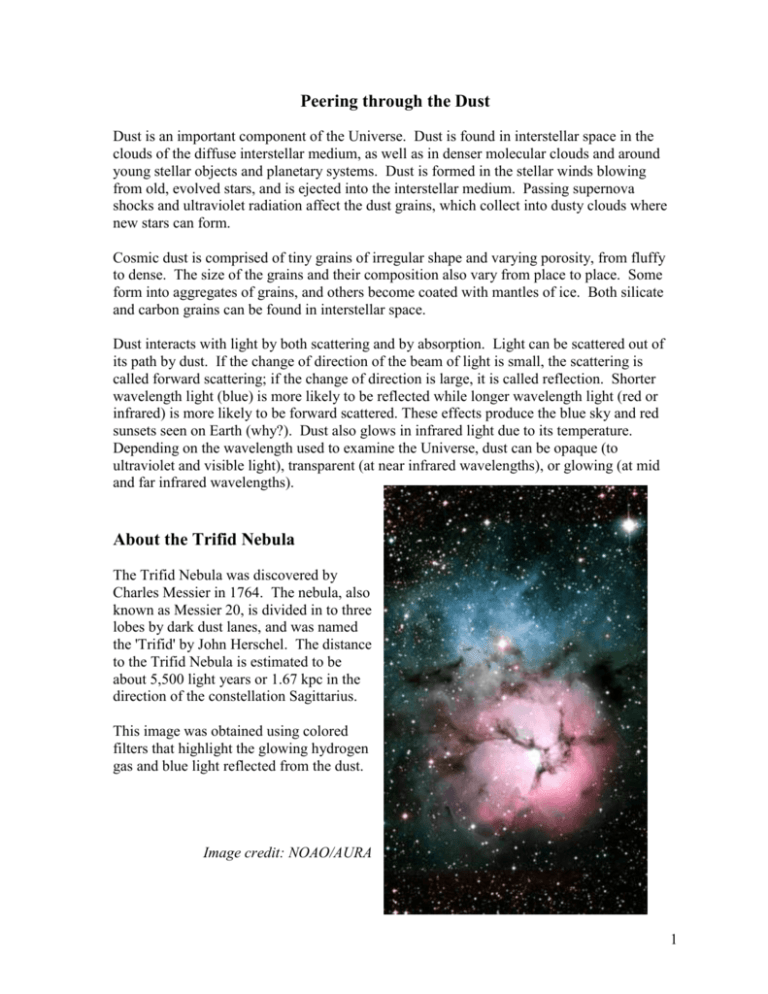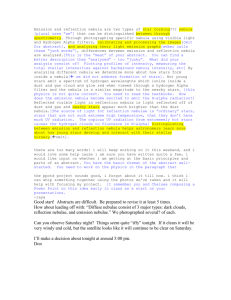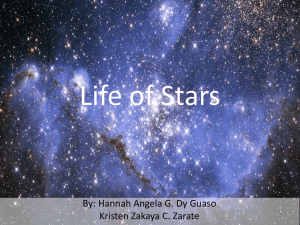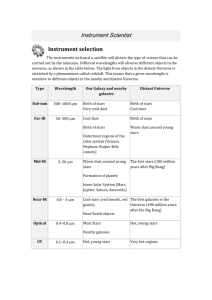Student Worksheet
advertisement

Peering through the Dust Dust is an important component of the Universe. Dust is found in interstellar space in the clouds of the diffuse interstellar medium, as well as in denser molecular clouds and around young stellar objects and planetary systems. Dust is formed in the stellar winds blowing from old, evolved stars, and is ejected into the interstellar medium. Passing supernova shocks and ultraviolet radiation affect the dust grains, which collect into dusty clouds where new stars can form. Cosmic dust is comprised of tiny grains of irregular shape and varying porosity, from fluffy to dense. The size of the grains and their composition also vary from place to place. Some form into aggregates of grains, and others become coated with mantles of ice. Both silicate and carbon grains can be found in interstellar space. Dust interacts with light by both scattering and by absorption. Light can be scattered out of its path by dust. If the change of direction of the beam of light is small, the scattering is called forward scattering; if the change of direction is large, it is called reflection. Shorter wavelength light (blue) is more likely to be reflected while longer wavelength light (red or infrared) is more likely to be forward scattered. These effects produce the blue sky and red sunsets seen on Earth (why?). Dust also glows in infrared light due to its temperature. Depending on the wavelength used to examine the Universe, dust can be opaque (to ultraviolet and visible light), transparent (at near infrared wavelengths), or glowing (at mid and far infrared wavelengths). About the Trifid Nebula The Trifid Nebula was discovered by Charles Messier in 1764. The nebula, also known as Messier 20, is divided in to three lobes by dark dust lanes, and was named the 'Trifid' by John Herschel. The distance to the Trifid Nebula is estimated to be about 5,500 light years or 1.67 kpc in the direction of the constellation Sagittarius. This image was obtained using colored filters that highlight the glowing hydrogen gas and blue light reflected from the dust. Image credit: NOAO/AURA 1 The red emission nebula, glowing with the characteristic light of hot hydrogen gas, hides a young star cluster near its center. The dust lanes appear dark because they obscure visible light, and are thus seen in silhouette against the brighter, glowing, hydrogen gas. Surrounding the red nebula is a blue reflection nebula, especially bright at northern end. The reflection nebula glows by reflecting the light of hot, massive, young stars. At the center of the Trifid Nebula is a new star cluster. Star clusters are groups of stars that form together from a cloud interstellar gas within a short time. If the cluster has enough mass, the stars will remain together through their mutual gravitational attraction. Often, however, the stars will begin to separate once they emerge from the cloud in which they form, and the cluster will dissipate. Counting Stars Below are images of the Trifid Nebula in three wavelength regions, optical red light (left), near infrared light from Spitzer's IRAC instrument (center), and mid-infrared light (24 m, right) from Spitzer's MIPS camera. The images are shown as "negatives," in which the sky is white and the stars are dark. Astronomers often portray images on the sky as negative because the stars are easier to see. Examine the three images and describe the primary contents of each. Which contains the most stars? In which is the gas and dust most visible? 2 What to do Copies of the visible light and near-infrared images are available with a superimposed grid that divides the star field into sub-regions. Our goal is to estimate the amount of extinction by dust in each sub-region by determining the ratio of the number of stars seen in the nearinfrared image to the number of stars seen in the visible light image. This ratio will vary depending on the amount of dust. Once the ratio is determined for each square, the measurements can be used to make a color map of the extinction that can be compared to the mid-infrared image obtained with Spitzer. The activity is best done in groups, with the work divided among a small group of students. Step 1. Count the number of stars in each square of the IR image. Use a highlighter to mark the stars counted to avoid recounting the same stars. Record the number in each square in the recording grid. Step 2. Count the number of stars in each square of the visible images. Use a highlighter to mark the stars counted to avoid recounting the same stars. Record the number in each square in the recording grid, under the number of IR stars counted. Step 3. In each square, compute the ratio of the number of IR stars to the number of visible stars, and record the number in the square. Circle the ratio in each square. Step 4. Create a color transformation for the ratio of IR/visible stars. Divide the range from the highest to the lowest ratio into five even parts, and assign a color to each range. For clarity of presentation, you may wish to use a color transformation of sequential colors, say green-yellow-orange-red-brown or yellow-green-blue-indigo-violet. Step 5. Use the color transformation to color the Color Grid, using the appropriate color for each square based on the ratio of IR/visible stars for that square. Step 6. Compare your color map of the amount of extinction of visible light compared to infrared light with the 24 mm image of the same region from Spitzer. 3 How does your color map of extinction around the Trifid Nebula compare to the mid-IR image of the same region? What does the comparison of the color map with the mid-IR image suggest about the source of extinction in this region? 4





